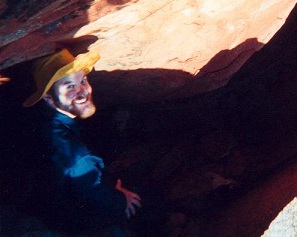I can trace my enthusiasm for bats back to this picture:
This was taken in 2001, at a rock pile in the Pilbara, on my first ever professional field survey. I was paired up with Kyle Armstrong to undertake some investigations of the rock piles and the bats that were in them – I was jammed down this crevice while we were setting up mist nets and trapping bats, and I was pretty much spellbound by them after the first one that we caught. I have many vivid memories of these days as a field ecologist – many more bat surveys were undertaken and they are definitely highlights of my career.
So last week in Melbourne I found myself in a room full of likeminded people (including Grit from our office), and presented about “Technology and Bats” at the Australasian Bat Society (ABS) conference at the University of Melbourne.
The talk I gave was mainly about the Biological Data Recording System, and the use of it in two projects – the Australasian Bat Echolocation Database (ABED) and our own research into the bats in the Perth area. The ABED component of the talk answered a few queries I heard during the conference about having a single location to store bat reference calls and other survey data. Kyle (who is also now the President of the Australasian Bat Society) has been the one who has done the majority of the work on this project, and is currently finalising the site ready for launch.
Our own research project was really included to see what else you can do with the system, and to show a real world example of how it is being used to undertake a relatively typical survey. So far we’ve been focusing in this first year on the technology, although we are gathering the ‘right’ information as well, so it looks like we will be able to do something interesting with the data as well… but stay tuned to that later.
The conference itself was a real eye opener. My overwhelming impression was that the community around the ABS is a very open and friendly community, and they have a wealth of talented people involved. I saw presentations from students which really impressed me, and I learned more about flying fox urine and virus shedding than I thought possible in a couple of days. There was a real eye opening session about acoustic technologies, and how in some cases it’s just not possible to tell certain bat species apart just on acoustic recordings, but that there are so many ways to look at calls using all sorts of recordings, such as full-spectrum records.
One of the more exciting outcomes is the proposed Cape York trip for the ABS members. There is a scarcity of reference calls for the species found in the Cape York region in northern Queensland, so there was a proposal to head up there in teams and do some survey work to collect calls. The ABED project would be a great place to store these reference calls, and we will be investigating if we can help out on this survey – I hope that our team will be able to go along and help run the technology behind these surveys in the field, provide mobile devices, and help gather all this data electronically. If we do get to do this, it will be a great experience, and will really help to bed down the system with the people that will be the ones using it.
We were also very impressed with the public forum – although I didn’t get to go to it, I made it back in time to see the people who were there gather around for a drink or two, and Grit got to see it. The forum was all about providing a way for people to see what is going on and learn a few more things about bats and debunk some of the myths. You can grab the fact sheets about bats from the ABS web site here – http://ausbats.org.au/#/bat-information-sheets/4562894228 – where you can find out some of the truths about these amazing creatures. Impressively, 33 Melbourne Councils also sent a representative – so bats are high on the agenda for a range of institutions.
Grit and I had a great time at the conference. We met a bunch of interesting people, we learned more about how we could tune our research, and we found some opportunities to collaborate. As an example, we hope to be collaborating with a PhD student in Melbourne who is doing her doctorate on urban bats and waterbodies in Melbourne – so we’ll hopefully give her something to compare her data on Melbourne to.
I would go to this conference again in a heartbeat. It was a great series of talks, there were some really good learning experiences for us professionally – and I got to relive some of the best times I’ve had in my career, even if it was in Melbourne rather than a rock pile in the Pilbara.
Piers


Comments are closed.